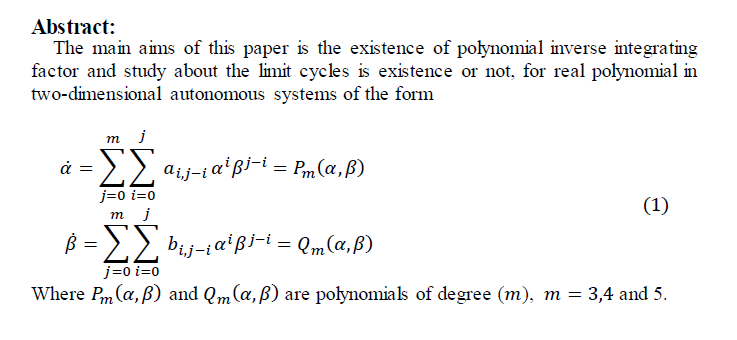 (26)
(26)
 (24)
(24)
The behaviour of certain dynamical nonlinear systems are described in term as chaos, i.e., systems' variables change with the time, displaying very sensitivity to initial conditions of chaotic dynamics. In this paper, we study archetype systems of ordinary differential equations in two-dimensional phase spaces of the Rössler model. A system displays continuous time chaos and is explained by three coupled nonlinear differential equations. We study its characteristics and determine the control parameters that lead to different behavior of the system output, periodic, quasi-periodic and chaos. The time series, attractor, Fast Fourier Transformation and bifurcation diagram for different values have been described.
 (40)
(40)
 (29)
(29)
The issue, the existence of God Almighty, and the creativity of the universes including the whale, and assets and how diversified, and faith in him and his lordship and divinity, is a delicate issue, and very important and dangerous, and it occupied human thought old and new, and still occupy it until God takes the land and on it. Many complex issues of thought, behavior, and ethics have resulted in the belief of many communities in the existence of the Almighty, having ruled their minds, depicting their beliefs and distancing their thoughts about slippage and abuse. When they looked at the wonders of creatures and the minutes of the assets, they thought about the planetary and astronomical motion systems. His existence was denied by ath
... Show More (41)
(41)
 (43)
(43)
 (53)
(53)
 (54)
(54)
The study aimed to identify the degree of academic leaders practices at the University of Northern Border for creative leadership, which attribute to different variables (nature of work, employer, gender, years of experience in administrative work at the university). To achieve the goal of the study, the researcher used the descriptive approach survey. Therefore, the researcher used a questionnaire as a study tool, which consisted of (40) items that included dimensions (sensitivity to problems, initiative, originality, flexibility). The study sample consisted of (240) participants included (agents of colleges, and supporting deanships, and their employees) during the second semester of the academic year 1439/1440 AH. The results showed t
... Show MoreIn this paper, a fast lossless image compression method is introduced for compressing medical images, it is based on splitting the image blocks according to its nature along with using the polynomial approximation to decompose image signal followed by applying run length coding on the residue part of the image, which represents the error caused by applying polynomial approximation. Then, Huffman coding is applied as a last stage to encode the polynomial coefficients and run length coding. The test results indicate that the suggested method can lead to promising performance.
 (7)
(7)

